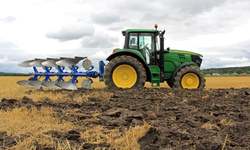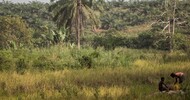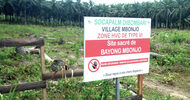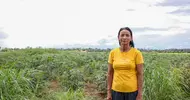
The decline in smallholdings worldwide is causing a rise in destructive monocultures. (Photo: Taina Sohlman/Alamy Stock Photo/Alamy)
1% of farms operate 70% of world's farmland
by Jonathan Watts
One per cent of the world’s farms operate 70% of crop fields, ranches and orchards, according to a report that highlights the impact of land inequality on the climate and nature crises.
Since the 1980s, researchers found control over the land has become far more concentrated both directly through ownership and indirectly through contract farming, which results in more destructive monocultures and fewer carefully tended smallholdings.
Taking the rising value of property and the growth of landless populations into account for the first time, the report calculates land inequality is 41% higher than previously believed.
The authors said the trend was driven by short-term financial instruments, which increasingly shape the global environment and human health.
“In the past, these instruments were only of concern to the markets. They didn’t affect us individually. But now they touch every aspect of our lives because they are linked to the environmental crisis and the pandemic,” said Ward Anseeuw, senior technical specialist at the International Land Coalition, which led the research along with a group of partners including Oxfam and the World Inequality Lab.
The study published on Tuesday, is based on 17 new research papers as well as analysis of existing data and literature.
It says previous calculations of land inequality were based exclusively on ownership and the size of individual farms. On this basis, land inequality narrowed until the 1980s, after which it became wider.
That trend is more pronounced under the new methodology, which takes additional factors into account, such as multiple ownership, the quality and value of land, and the number of landless people.
Landlessness was lowest in China and Vietnam, and highest in Latin America, where the poorest 50% of people owned just 1% of the land.
Asia and Africa have the highest levels of smallholdings, where human input tends to be higher than chemical and mechanical factors, and where time frames are more likely to be for generations rather than 10-year investment cycles. Worldwide, between 80% and 90% of farms are family or smallholder-owned. But they cover only a small and shrinking part of the land and commercial production.
Over the past four decades, the biggest shift from small to big was in the United States and Europe, where ownership is in fewer hands and even individual farmers work under strict contracts for retailers, trading conglomerates and investment funds.
Ward said these financial arrangements are now spreading to the developing world, which is accelerating the decline of soil quality, the overuse of water resources, and the pace of deforestation.
“The concentration of ownership and control results in a greater push for monocultures and more intensive agriculture as investment funds tend to work on 10-year cycles to generate returns,” he said.
This is also connected to social problems, including poverty, migration, conflict and the spread of zoonotic diseases like Covid-19.
To address this, the report recommends greater regulation and oversight of opaque land ownership systems, a shift in tax regimes to support smallholders and better environmental management, and great support for the land-rights of communities.
“Smallholder farmers, family farmers, indigenous people and small communities are much more cautious with use of land. It’s not just about return on investment; it’s about culture, identity and leaving something for the next generation. They take much more care and in the long run, they produce more per unit area and destroy less.”












